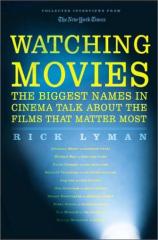Watching Movies: The Biggest Names in Cinema Talk About the Films That Matter Most
Review
Watching Movies: The Biggest Names in Cinema Talk About the Films That Matter Most
Chicago or Gangs of New York? Nicole Kidman or Renee
Zellweger? The Academy Awards are just days away, placing many of
us in the grip of Oscar fever. The Oscars are a unique media event.
It has the star power, glamour and --- when done right ---
production value to transfix a worldwide audience. As we follow the
Oscar races and check off boxes in our office pools, this is a
great time to read and think about movies.
In 2000, Rick Lyman began writing articles for The New York
Times in a series titled "Watching Movies With." The set-up was
simple. Lyman and a subject (almost always an accomplished actor or
director) watched a movie chosen by the filmmaker. While watching
the movie, the subject discussed the things they saw and felt that
made the movie important to them. Lyman's series enjoyed great
popularity and the articles have been compiled into a book called
WATCHING MOVIES. The book works for the simple reason that it
presents serious filmmakers as movie lovers. And with only one
glaring exception, they were all able to smartly and precisely
communicate --- often in emotional ways --- why we go to the
movies.
The book includes twenty-one articles with filmmakers who chose
deeply personal movies they saw as children or young men and women.
Harvey Weinstein, founder of and producer at Miramax Films, was
twelve years old when he saw Exodus in 1960. He picked this
movie because he was moved by the portrayal of Jews fighting for
their own homeland in the post-World War II era. "I see Jerusalem
here," Weinstein says, "and I feel like going there tomorrow." Ang
Lee, the great director of movies like The Ice Storm and
Crouching Tiger, Hidden Dragon chose a Chinese-made film
called Love Eternal, which he saw while growing up in
Taiwan. It was not "the greatest movie" he's seen. "But there is
something so honest . . . about it. I cry. I always cry . . . I
watch it for that feeling, the feeling of the innocence of watching
a movie and wanting to believe."
Many of the filmmakers agreed that movies made in the last quarter
century --- movies they made and starred in --- do not measure up
to those they grew up with. None suggested that movies today are
better than those in generations past. In Kevin Costner's razor
sharp analysis of Cool Hand Luke, he laments how filmmakers
today are afraid --- afraid to linger on a crucial moment, afraid
to go quiet when, in fact, silence may be the most effective way to
convey certain messages. Costner, director Barry Levinson and
others attribute these fears to a Hollywood culture obsessed with
hurrying up, cutting quick and making audiences feel good at the
expense of movie quality. And they have a point.
The MTV-ization of American cinema is nearly complete. Audiences
are overwhelmed with seizure-inducing quick cuts, dumbed-down
dialogue and hyper-pacing that gets way ahead of whatever plot
lines may be developing. One of the chief purveyors of this style
of filmmaking is Michael Bay, the director of empty summertime
blockbusters like The Rock and Pearl Harbor. Bay's
segment in WATCHING MOVIES is by far the least insightful. He chose
to watch West Side Story and at one point commented, "Oh
man, that's a great cut." Lyman asked Bay what makes a great cut
and Bay responded, "It's very hard to describe what makes a good
cut. I know it when I see it." He knows it when he sees it? In
other words, a powerful Hollywood director whose movies cost $100
million cannot, for the life of him, explain what makes a good cut.
Bay should check in with Denzel Washington, who beautifully
deconstructs the 1980 drama Ordinary People. He explains
that a well-timed cut keeps the audience involved in the story. One
cut was "a visual way of tying two scenes together. Having . . .
one light going off and then a cut to another light going off"
simultaneously connects one scene to the next.
One of the book's chief pleasures is in feeling the filmmakers'
passion for the movies. Three filmmakers --- grown men! ---
literally slapped their knees in joy during pivotal moments in
their movies of choice. Quentin Tarantino, the unsentimental
director of violence infused movies like Pulp Fiction and
Reservoir Dogs, got all squishy over the love between a man
and his horse in The Golden Stallion, featuring Roy Rogers
and Trigger. John Travolta was emotional for much of his viewing of
Yankee Doodle Dandy with James Cagney. It turns out that
Travolta, our Yankee Disco Dandy, idolized Cagney and the two
developed a warm friendship late in Cagney's life. Travolta could
not fight back the tears while watching Cagney's deathbed scene at
the end of the movie.
Lyman skillfully rounds out the filmmakers' analysis by, for
example, economically explaining important plot points in many of
the movies, or defining directing techniques mentioned by the
subjects. The articles all have a natural flow; Lyman never steps
on a subject's comments or otherwise intrudes on a great point. And
while all the subjects (except Bay) were wonderful, one wonders why
Lyman included five directors in their 30's. This is a
disproportionate number, especially considering that WATCHING
MOVIES includes only three women and, bafflingly, no screenwriters.
These minor quibbles aside, this is a great book that has come out
at the perfect time. Enjoy WATCHING MOVIES and enjoy the
Oscars!
Reviewed by Andrew Musicus on January 24, 2011
Watching Movies: The Biggest Names in Cinema Talk About the Films That Matter Most
- Publication Date: March 3, 2003
- Paperback: 288 pages
- Publisher: Times Books
- ISBN-10: 0805070982
- ISBN-13: 9780805070989









